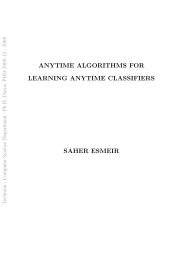Computing Extremal Quasiconformal Maps - Technion
Computing Extremal Quasiconformal Maps - Technion
Computing Extremal Quasiconformal Maps - Technion
Create successful ePaper yourself
Turn your PDF publications into a flip-book with our unique Google optimized e-Paper software.
0.7<br />
0.4<br />
0.1<br />
O. Weber & A. Myles & D. Zorin / <strong>Computing</strong> <strong>Extremal</strong> <strong>Quasiconformal</strong> <strong>Maps</strong><br />
harmonic ARAP q.c.<br />
ARAP<br />
Figure 12: Parametrization with aligned sharp features and<br />
boundary. We cut the front of the fandisk model to obtain a<br />
disk-like surface and flatten it while aligning the sharp features<br />
and boundary to parametric lines using harmonic map,<br />
ARAP and our extremal q.c. map. The color visualization<br />
and histograms shows values of k between 0.1 to 0.7.<br />
Figure 13: Parametrization aligned to the boundaries of a<br />
large curved multiply connected model using our q.c. extremal<br />
algorithm. The disk-topology of the surface is maintained.<br />
i.e., no cones or cuts are introduced. Top row: a texture<br />
of regular grid is mapped onto the surface. Bottom row:<br />
a quadrangular mesh (left) is obtained by sampling the parametric<br />
domain (right). In contrast to Figure 18, here we use<br />
the original surface metric.<br />
ture many common types of requirements needed in applications.<br />
For example, the parametrization may need to be close<br />
to isometric, and dilatation does not take area distortion into<br />
account. In other cases, we may want the parametric lines<br />
to be aligned with features etc. One can use extremal quasiconformal<br />
maps in composition with a metric defined using<br />
a different parametrization type as explained in Section 4.2.<br />
Figure 18 shows several examples of this type.<br />
Figure 19 demonstrates the behavior of our algorithm<br />
when pushed to the limit. A multiply connected ball shaped<br />
surface with twelve pentagonal holes is mapped to a disk<br />
without introducing any cuts. One of the holes is mapped<br />
to the boundary of the disk while all the others are mapped<br />
to fixed circles inside the disk. With such extreme boundary<br />
conditions, large amount of conformal distortion is unavoidable.<br />
Nevertheless our algorithm manage to produce a bijective<br />
map without any foldovers. Harmonic map with exact<br />
same boundary conditions is much smoother. However the<br />
c○ 2012 The Author(s)<br />
c○ 2012 The Eurographics Association and Blackwell Publishing Ltd.<br />
source<br />
q.c.<br />
Figure 14: Image deformation. A doughnut is deformed to<br />
have different thickness using ARAP and extremal q.c. map.<br />
Note the foldovers ARAP develops.<br />
Beltrami Harmonic ARAP<br />
Beltrami ARAP MIPS<br />
Figure 15: Comparison of the results for several energies:<br />
an extremal quasiconformal map, harmonic, ARAP, MIPS.<br />
As MIPS energy is infinite at foldovers, it was initialized on a<br />
less challenging configuration with bijective output of ARAP.<br />
conformal distortion is extremely high, leading to more than<br />
800 flipped triangles. ARAP parametrization produce similar<br />
result with more than 600 flipped triangles.<br />
6. Conclusions and future work<br />
From computational point of view, quasiconformal maps,<br />
i.e. maps with globally bounded dilatation, are a natural way<br />
source<br />
irregular<br />
regular<br />
Figure 16: Comparison of maps obtained for regular and<br />
irregular meshes<br />
0.6<br />
0.3<br />
0











